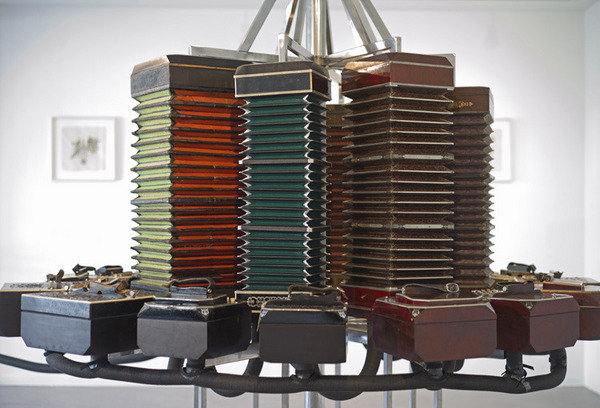Constantin Luser
dal 6/9/2012 al 19/10/2012
Segnalato da
6/9/2012
Constantin Luser
Galerie Jette Rudolph, Berlin
Luser drawing always serves as his starting point, but his work also largely consists of three-dimensional installations and collages. With his sound sculptures, the artist not only creates spatial objects, but also makes them available as an acoustic experience.

The sphere is the interior, disclosed, shared realm inhabited by humans – in so far as they succeed in becoming humans. Because living always means building spheres, both on a small and a large scale, humans are the beings that establish globes and look out into horizons. Living in spheres means creating the dimension in which humans can be contained. – Peter Sloterdijk
The Jette Rudolph Gallery is pleased to present Constantin Luser’s third solo show at the gallery. A native of Graz, Austria, drawing always serves as his starting point, but his work also largely consists of three-dimensional installations and collages. With his sound sculptures, the artist not only creates spatial objects, but also makes them available as an acoustic experience; this is to encourage viewers to interact on performative and communicative levels with the works. The sound-producing instruments are arranged as objects and fill the room along with the large-format, intricate drawings the artist is known for.
With his labor-intensive works, Constantin Luser dismantles the contents of sent messages, recalibrating them, and ultimately restructuring and compressing them into multifaceted, partly imaginative constructs. Using found objects, scenes from memories, personal thoughts, experiences and viewpoints, Luser’s ideas continually evolve into expressive, multivalent structures.
The focal point of Luser’s current solo exhibition is an octagonally arranged installation piece with eight bandoneons. Equipped with a centralized air system, the octagon of harmonica instruments can be played polyphonically. At the same time, the sculpture also serves as a reference to the reed instrument’s colorful history. Created by a German, Heinrich Band, in the 19th century, it was banned by the Nazis, but still enjoyed tremendous popularity, especially in South America.1
The sculpture is accompanied by several small-format collages whose fragments were extracted from the 1936 to 1942 edition of the “Brauner Meyer,2” an encyclopedia that had a National Socialist bias. Employing a free and associative creative process, Luser rearranges the photo material, combining some of it with his own drawings. Removed from their original context and their supposedly objective function as encyclopedia images, the wood engravings come across as ideologically tinged and, rearranged as a collage, disclose their communicative character. Luser subjects the declamatory images to a process, thereby setting the fragments into dialog with one another under new conditions.
In each of the artist’s works, different levels of meaning and perception converge. This can also be seen in his large-format, Alu-Dibond drawings. With accurate and precise lines, Luser draws idea-networks that resemble complex plans. In various, alternating levels, the abstract forms, figurative moments, encryptions and symbols fuse, creating a connective network that is a combination of reality’s influence, the imagination and the artist’s personal thoughts. The artist uses color glazes in some of his works, which sometimes triggers synesthetic experiences.
The various dimensions of meaning intrinsic to the works in conjunction with the real-world spaces all come together – whether pictured, described or mapped – with absolutely fantastic details. Because as Paul Valéry aptly notes, “Drawing may be the most haunting obsession the mind can experience.”3 It is therefore hardly surprising that the notion that there are utterly endless ways to present images is carried on in Luser’s works – in the collage medium with its manifold opportunities for combination and visualization. Narratively situated between the inner and outer worlds, the images enter into negotiations with the viewer, who faces one basic challenge: to follow the structures that have been established. In places that are blurry on many levels, the surprising potential created by experimentally leaving reality-oriented perception behind turns out to be a desire for development and transcendence. Beyond any type of real-time integration, Luser’s works open dynamic, imaginary spaces filled with semantic fields the viewer continually has to adapt to.
[1] Starting in the early 20th century, the instrument had a major influence on Tango music.
[2] The 8th edition of the Meyer encyclopedia was published in 9 volumes and, due to the war, was never finished. The NSDAP Censorship Committee revised large portions of the various entries.
[3] Paul Valéry, in Degas, Dance, Drawing.
Opening: 7. September, 2012, 18:00 - 22:00
Galerie Jette Rudolph GmbH
Strausberger Platz 4, D- 10243 Berlin
open: Tues- Sat 12.00 am- 6 pm



